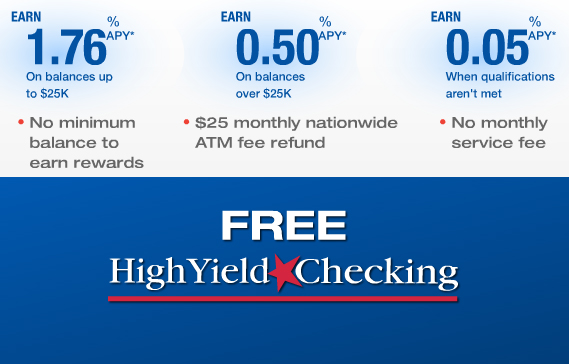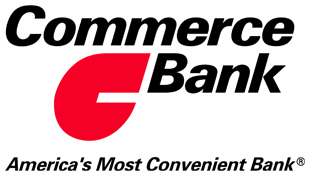Earlier this month, I noticed an advertisement on my local bank’s website. The advertisement said something like “FREE HIGH YIELD CHECKING – 2.01% APR!” Like most folks, I really don’t pay much attention to these advertisements on the interwebs because, you know, who has the time to worry about those things? So I paid no attention to the advertisement the first time I saw it or the second, third, or fourth times I saw it. In fact, I really didn’t pay the advertisement any mind until about a week and a half ago when I was sitting around thinking about the different financial institutions where I keep my various accounts and investments. Since this advertisement was telling me that I could get a high yield (i.e. earn a better-than-average interest rate) on money sitting in my checking account, I thought I should probably investigate what they were offering. After a few clicks on the Kearny Federal Savings website (I bank with Central Jersey Bank, which is now a division of Kearny Federal Savings) and I was reading information on the free high yield checking account option. According to what I read on the web, it appeared that my usage patterns in my checking account qualified me to get one of these high yield accounts and I could earn myself a cool 2.01% APR.

Here is the ad that was on my bank's site. Notice the rate has fallen to 1.76% from 2.01%.
Like most people, I don’t like to mess with my day-to-day banking or investment accounts so I took some time to mull over whether I should bother with the high yield account or just leave well enough alone. Though it took me a few days, I finally decided to go over to my local branch of Central Jersey Bank and talk to them about the high yield checking account option.
There’s no great “POW!” moment to end this portion of the entry, so be forewarned. I went over to the branch and the woman who assisted me was excellent and showed me how my usage qualified for the high yield checking account. We talked about the different checking account options and I opted to go with this account. So now my checking account is earning 1.76% (the rate went down a few days ago and will probably continue to go down each month – hey, I know it’s a promotion, but it’s a good one).
While I was talking to the woman at the bank, I thought I might open up a savings account, too. I haven’t had a savings account at a brick-and-mortar bank in a long time – probably dating back to when I was in my first or second year of college (which, terrifyingly enough, was over a decade ago). For a long time now I’ve had a savings account at ING Direct and I’ve been very happy with its performance. Of course, the initial interest rate that I was receiving over at ING Direct was something like 4.50% and that’s dropped down to 0.90%, but I understand that the drop was more a function of a poor financial market than factors inside ING Direct (or any other bank for that matter). Anyway, I wanted to open up a savings account and two issues stopped me dead in my tracks.

I wound up staying with ING Direct
A $3 fee for not keeping at least $1,000 in a 0.30% savings account? Yeah right! Give me a break.
Instead of dealing with that hot mess, I decided to just stick with my ING Direct account as my only savings account. I would liked to diversify and have a second savings account, but silly restrictions like the one noted above are not something that I have the time or the inclination to worry about. With respect to savings accounts, though, I’m thinking about looking into Ally Bank since they’re offering a similar rate to ING Direct (0.85%).
This process did get me thinking, though. In particular, I started thinking more about the checking account that I use for Usable Web Solutions, LLC. I keep most of the funds for my small website business in Sovereign Bank, but I really haven’t been thrilled with their service since they were acquired by Santander a few years ago. Certain things have become a hassle that shouldn’t be a hassle. For example, they rebranded and changed their debit cards and so they sent me a new one to use. Like any new debit card, I had to activate it over the phone. The problem was that the phone activation system forced me (automatically for some reason) to an operator for final activation. Then this woman on the activation line may have asked me 50 questions to get this stupid card (which I didn’t want, request, or need) activated.

I'm not sold on Santander's customer service
And then TD Bank came in and crapped all over Commerce Bank’s customer-friendly reputation, but that’s another story.
In any event, this entire process has me thinking about some of my other banking and investment accounts. I’ve scheduled a meeting with my company’s 401k agent to talk to her about my asset allocation in my 401k account. For some reason, I’ve got a gut feeling that now is the time to invest heavily in aggressive, struggling funds. Yeah, they’re probably going to go down again, but I think they’re going to come roaring back in the next 2 – 3 years. I guess we’ll see, but I want to meet with the agent to be sure that my feeling is reflected adequately in my asset allocation.

Ahhh... the good old days!
Since the only thing keeping me hanging on to this credit card is the Worldpoints feature, I’ve been researching other “cash back” credit cards and all of the reviews point me towards the Freedom Chase card. Sure, the interest rate is a bit high and variable (both unacceptable for someone who isn’t a credit risk at all), but I don’t carry a balance anyway so I wouldn’t be paying the interest. Plus, there are a variety of ways to double, triple, quadruple, and quintuple (that’s “multiply times five,” folks) the amount of points that you get for certain purchases with the Freedom Chase card.
So I’ve been thinking about possibly getting that card. And I’ve also been looking into the Barnes & Noble MasterCard because, you know, I’m a Barnes & Noble fan. They’re big draw is that for everyone 2,500 points you earn (i.e. every $2,500 you spend on the credit card), you get a free $25 Barnes & Noble gift card sent to you. You also get 5% off everything at their store. There are some months where I spend more than $2,500 on my credit card, so getting that monthly gift card would be nice. But then again, it would also be nice to build a whole bunch of points with Freedom Chase and get cash back instead of a gift card.
Nothing wrong with one of these big, massive banks sending me a check every once in a while, you know?
Anyway, what about the rest of you? Is anyone else out there reassessing where they put their money and which financial products they use during this cloudy economic climate?